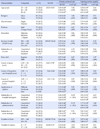Abstract
Purpose
This study investigated the correlation between person-centered care (PCC) and nursing service quality of nurses in long-term care hospitals.
Methods
The subjects were 114 nurses working in 8 long-term care hospitals. Instruments for evaluating PCC and nursing service quality were used. The data were analyzed by descriptive statistics, two samples-test, one-way ANOVA, Pearson's correlation and Multiple regression.
Results
The mean of PCC was 3.25±0.45 out of 5 and the nursing service quality was 3.87±0.40. There were significant differences in PCC in terms of age and income satisfaction, the application of their opinions, the satisfaction of hospital managers, administrators and nurse managers. There were significant differences in nursing service quality according to age, position, the satisfaction of hospital managers, administrators and nurse managers. Nurses' PCC showed a significant positive correlation with nursing service quality. Factors influencing nursing service quality included PCC, their position and age and the most influencing one was PCC.
Figures and Tables
Table 1
Person-centered Care of Participants

Table 2
Nursing Service Quality of Participants

Table 3
Person-centered Care and Nursing Service Quality according to Participants' Characteristics

References
1. Korean Statistical Information Service. Status classes of medical care institutions in region. [Internet]. Seoul: Statistics Korea;2016. cited 2016 March 16. Available from: http://kosis.kr/statHtml/statHtml.do?orgId=354&tblId=DT_MIRE01&vw_cd=MT_ZTITLE&list_id=354_MT_DTITLE&seqNo=&lang_mode=ko&language=kor&obj_var_id=&itm_id=&conn_path=E1.
2. Lee YK, Kim SJ. A study on the systematization of service quality management system of long-term care (LTC). Health Soc Welf Rev. 2012; 32(4):66–93.
3. Lee MJ. Plan of securing long-term care insurance's public character [Internet]. Seoul: Monthly Welfare Report;2009. cited 2016 March 13. Available from: http://www.peoplepower21.org/Welfare/667122.
4. Lee MJ. A study on measurement issues of the quality of longterm care services for older adults. Soc Welf Policy. 2011; 38(1):141–165. DOI: 10.15855/swp.2011.38.1.141.
5. Yoon JY, Roberts T, Bowers BJ, Lee JY. A review of person-centered care in nursing homes. J Korean Gerontol Soc. 2012; 32(3):729–745.
6. Crandall LG, White DL, Schuldheis S, Talerico KA. Initiating person-centered care practices in long-term care facilities. J Gerontol Nurs. 2007; 33(11):47–56.

7. Morgan S, Yoder LH. A concept analysis of person-centered care. J Holist Nurs. 2012; 30(1):6–15. DOI: 10.1177/0898010111412189.

8. de Silva D. Helping measure person-centred care [Internet]. London, UK: The Health Foundation;2014. cited 2015 May 15. Available from: http://www.health.org.uk/publication/helping-measure-person-centred-care.
9. Edvardsson D, Fetherstonhaugh D, Nay R, Gibson S. Development and initial testing of the person-centered care assessment tool (P-CAT). Int Psychogeriatr. 2010; 22(1):101–108. DOI: 10.1017/S1041610209990688.

10. Brownie S, Nancarrow S. Effects of person-centered care on residents and staff in aged-care facilities: A systematic review. Clin Interv Aging. 2013; 8:1–10. DOI: 10.2147/cia.s38589.

11. Kwon SM, Kim HS, Won JW, Lee JY, Kim H. Study on the improvement of health and long-term care system for the elderly based on field survey and insurance data analysis. Research Report. Seoul: National Health Insurance Service;2013. 10. Report No: EM014523.
12. Tak YR, Woo HY, You SY, Kim JH. Validity and reliability of the person-centered care assessment tool in long-term care facilities in Korea. J Korean Acad Nurs. 2015; 45(3):412–419. DOI: 10.4040/jkan.2015.45.3.412.

13. Edvardsson D, Innes A. Measuring person-centered care: A critical comparative review of published tools. Gerontologist. 2010; 50(6):834–846. DOI: 10.1093/geront/gnq047.

14. Lee SM. A study on differences between consumers and nurses of perception of customer-oriented core values for quality nursing services [dissertation]. [Seoul]: Yonsei University;2003. 161.
15. Lee MA. A study of the nursing service quality and gap perceived by consumers. J Korean Acad Nurs. 2004; 34(2):225–234.

16. Kim HK, Kwak MS. Correlation between personality types, leadership skills and nursing services among nurses in hospitals. J Korean Clin Nurs Res. 2006; 12(1):21–31.
17. Kim KS, Ha EH. Factors affecting quality of nursing services and intention to revisit as perceived by hospitalized patients and nurses in medium sized urban hospitals. J Korean Clin Nurs Res. 2009; 15(2):103–114.
18. Lee SH. Multi-level analysis of factors related to quality of services in long-term care hospitals. J Korean Acad Nurs. 2009; 39(3):409–421. DOI: 10.4040/jkan.2009.39.3.409.

19. Sohn M, Choi MK. Association between efficiency and quality of health care in South Korea long-term care hospitals: Using the data envelopment analysis and matrix analysis. J Korean Acad Nurs. 2014; 44(4):418–427. DOI: 10.4040/jkan.2014.44.4.418.

20. Edvardsson D, Fetherstonhaugh D, McAuliffe L, Nay R, Chenco C. Job satisfaction amongst aged care staff: Exploring the influence of person-centered care provision. Int Psychogeriatr. 2011; 23(8):1205–1212. DOI: 10.1017/s1041610211000159.

21. Korea Institute of Healthcare Accreditation. Accreditation status in region. [Internet]. Seoul: Korea Institute of Healthcare Accreditation;2015. cited 2015 October 5. Available from: http://www.koiha.kr/member/kr/certStatus/certList.do.
22. Parasuraman A, Zeithaml VA, Berry LL. SERVQUAL: A multiple-item scale for measuring consumer perceptions of service quality. J Retail. 1988; 64:12–40.
23. Sjogren K, Lindkvist M, Sandman PO, Zingmark K, Edvardsson D. Psychometric evaluation of the Swedish version of the person-centered care assessment tool (P-CAT). Int Psychogeriatr. 2012; 24(3):406–415. DOI: 10.1017/s104161021100202x.
24. Rokstad AM, Engedal K, Edvardsson D, Selbaek G. Psychometric evaluation of the Norwegian version of the person-centred care assessment tool. Int J Nurs Pract. 2012; 18(1):99–105. DOI: 10.1111/j.1440-172X.2011.01998.x.

25. Martinez T, Suarez-Alvarez J, Yanguas J, Muniz J. Spanish validation of the person-centered care assessment tool (P-CAT). Aging Ment Health. 2016; 20(5):550–558. DOI: 10.1080/13607863.2015.1023768.
26. Jang RJ. The relationships between emotional intelligence, job satisfaction, and quality of nursing service in hospital nurses [master's thesis]. [Jinju]: Gyeongsang National University;2015. 49.
27. Kim JH, Lee IS. The differences in quality perceptions, expectations, evaluation, and satisfaction for nursing service between patients and nurses: Small-medium sized general hospitals. J Korean Acad Nurs. 2004; 34(7):1243–1254.

28. Lee MA. A study of the perception gap on nursing service between consumers and providers. J Korean Acad Nurs. 2001; 31(5):871–884.

29. Lim ES. How to find a right nursing hospital. Shin Dong-A. 2013. 09. 24. p. 504–511.




 PDF
PDF ePub
ePub Citation
Citation Print
Print




 XML Download
XML Download